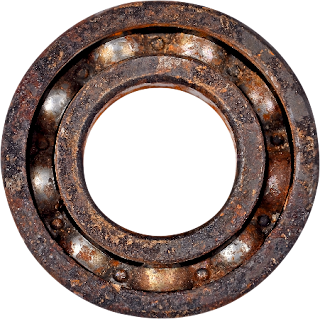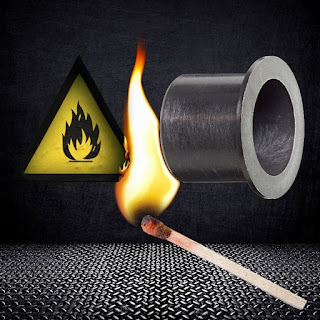 |
Figure 1. Bearing Failure Overview
|
Bearing failure happens when bearing fails to meet the desired performance level or life expectancy. Bearing failure can lead to productivity lost, revenue lost, worker injury, missing deliveries, production downtime, higher maintenance cost and efficiency reduction. It is important to understand the 13 causes of bearing failure in order to help you maximize your profit and minimize your production losses. Below are the 13 different bearing failures written by igus® bearing expert.
Lubrication Failure
 |
| Figure 2. Lubrication Used in Application |
Lubrication failure is the number one cause for bearing failure caused by improper handling of the lubricant. Machine without proper handling of the lubricant will experience metal to metal contact between the rolling elements, raceways and retainers resulting in an increase in wear and friction, reduction in bearing optimum life, overheating and contamination. Below are the causes of lubrication failure:
Bearing failure happens when bearing fails to meet the desired performance level or life expectancy. Bearing failure can lead to productivity lost, revenue lost, worker injury, missing deliveries, production downtime, higher maintenance cost and efficiency reduction. It is important to understand the 13 causes of bearing failure in order to help you maximize your profit and minimize your production losses. Below are the 13 different bearing failures written by igus® bearing expert.
• Incorrect lubricant quantity
Both under lubrication and over lubrication lead to bearing failure. Under lubrication makes it difficult for the lubricant to reach the correct viscosity and thickness level to prevent metal to metal contact. On the other hand, over lubrication makes the bearing do extra work to push the excess lubricant.
• Improper lubricant
Different lubricants such as oil, grease, etc are made for different applications. Choosing the wrong lubricant will harm or affect the bearing’s performance as it might not have the right property to complement the bearing’s application.
There are multiple factors that need to be considered when choosing the lubricant such as bearing’s operating condition, machine speed, bearing load, temperature, adhesion property, etc.
• Excessive temperature.
Excessive temperature can degrade the lubricant quality. Therefore, it is important to set the operating temperature to the recommended temperature by the manufacturer.
Contamination
 |
| Figure 3. Bearing Contaminant |
Foreign substances such as dirt, dust, grit, chip or tool that get inside bearing system can damage the rolling element (bruising & pitting). The contaminant also reduces lubricant’s viscosity and greatly increase the wear rate. It might even lead to corrosion on the bearing surface and disrupts the lubricant film formation.
Conducting routine maintenance and using additional protection such as bearing seal and shield are some of the solutions to prevent contaminants from entering the bearing system.
Improper Mounting
Bearing mounting is a crucial step and if not done properly can lead to bearing failure. Bearing should have a press fit when installed into the housing. Bearing that is mounted with inaccurate fit on the rotating ring, will damage and cause dents and cracks. It is important to use shaft with the correct diameter and follow the instruction when mounting the bearing.
Misalignment
Bearing misalignment is also one of the most common reasons why bearing fail and can be prevented by ensuring the alignment of the two rings. Rolling element bearing is prone to misalignment and it can be observed when the inner and outer ring’s surface are not on a straight parallel line. Some changes such as shaft’s bent, clamping and retainer that are out of space, improper installation, contaminant, etc are some of the factors that cause misalignment. Bearing misalignment will lead to excessive vibration & load, overheating and failure.
Brinelling
Brinelling is a permanent indentation of a hard surface. Brinelling is also one of the common cause of bearing failure. There are two types of brinelling: True brinelling and false brinelling. True brinelling failure is caused when the bearing’s load exceeds the elastic limit of the ring’s material. False brinelling is caused by vibration between the rolling element and the raceway. Proper mounting procedure and routine maintenance will greatly reduce the possibility of brinelling.
Corrosion
 |
| Figure 4. Bearing Corrosion |
Metal bearing, unlike polymer bearing, is prone to corrosion or rusting through chemical reaction forming metal oxides on its surface. Contact with element such as acid or moisture will oxidize the metal element, forming the yellow/reddish stain. Proper handling of bearing, routine maintenance or use corrosion-free bearing should help to prevent this failure.
Electrical Damage.
 |
| Figure 5. Electrical Damage in Bearing |
Electrical damage is caused by a constant electric current (AC or DC) that flows into the bearing. The current damages the contact surface between the raceway and rolling element, generating high temperature at specific local point. Electrical damage can be prevented with proper grounding or with insulating bearing.
Fatigue
Also known as spalling, this bearing failure is progressive by nature and caused by continuous and repeat machine cycle. Fatigue can be noticed by an increase in vibration and noise, and removal of particles from the bearing surface.
Replace bearing or consider to redesign your bearing with greater fatigue life to prevent this failure from occurring
Overheating
 |
Figure 6. Overheating in Bearing
|
Using higher than recommended operating temperature will lead to bearing failure. High temperature can cause grease to bleed and reduce the lubricant’s efficiency. Overheating might affect the metal property (e.g hardness) and even induce oxidation.
Excessive Load
 |
| Figure 7. Bearing for Excessive Load |
Overstretch your bearing load capacity is another common trigger for bearing failure. If this occur, reduce your bearing load or switch to a high capacity bearing.
Cage Damage
|
Figure 8. Picture of Bearing Cage
|
Bearing cage or retainer is part of a bearing that holds the bearing and separate the ball. If damaged, the cage might experience fracture, deformation and crack. Cage damage can be caused by vibration, excessive speed, poor handling, wear, misalignment, poor lubrication and high operating temperature.
Few ways to prevent cage damage is by ensuring proper alignment and correct application of the bearing.
Fit
Bearing needs to be mounted with the right shaft size. Improper sizing will cause fit that results in bearing failure. Shaft that is oversized will have small clearance which will generate friction and heat. Undersize shaft however will cause the bearing to creep on the shaft and generate heat and vibration.
To prevent this failure from happening, an adequate bearing clearance is needed to prevent heat built-up and maximize bearing’s service life.
Improper Storage and Handling
How you store your bearing will also help in preventing bearing failure. Bearing that is exposed to contaminants such as dust and dirt might lead to blockage, friction, misalignment or even corrosion.
Similar to overheating, higher than recommended storage temperature might also affect the grease, metal hardness and even induce oxidation.
Bibliography
Chris Wilson. (n.d.). https://www.reliableplant.com/.
Retrieved from Reliable Plant:
https://www.reliableplant.com/Read/30255/reasons-bearings-fail









Comments
Post a Comment